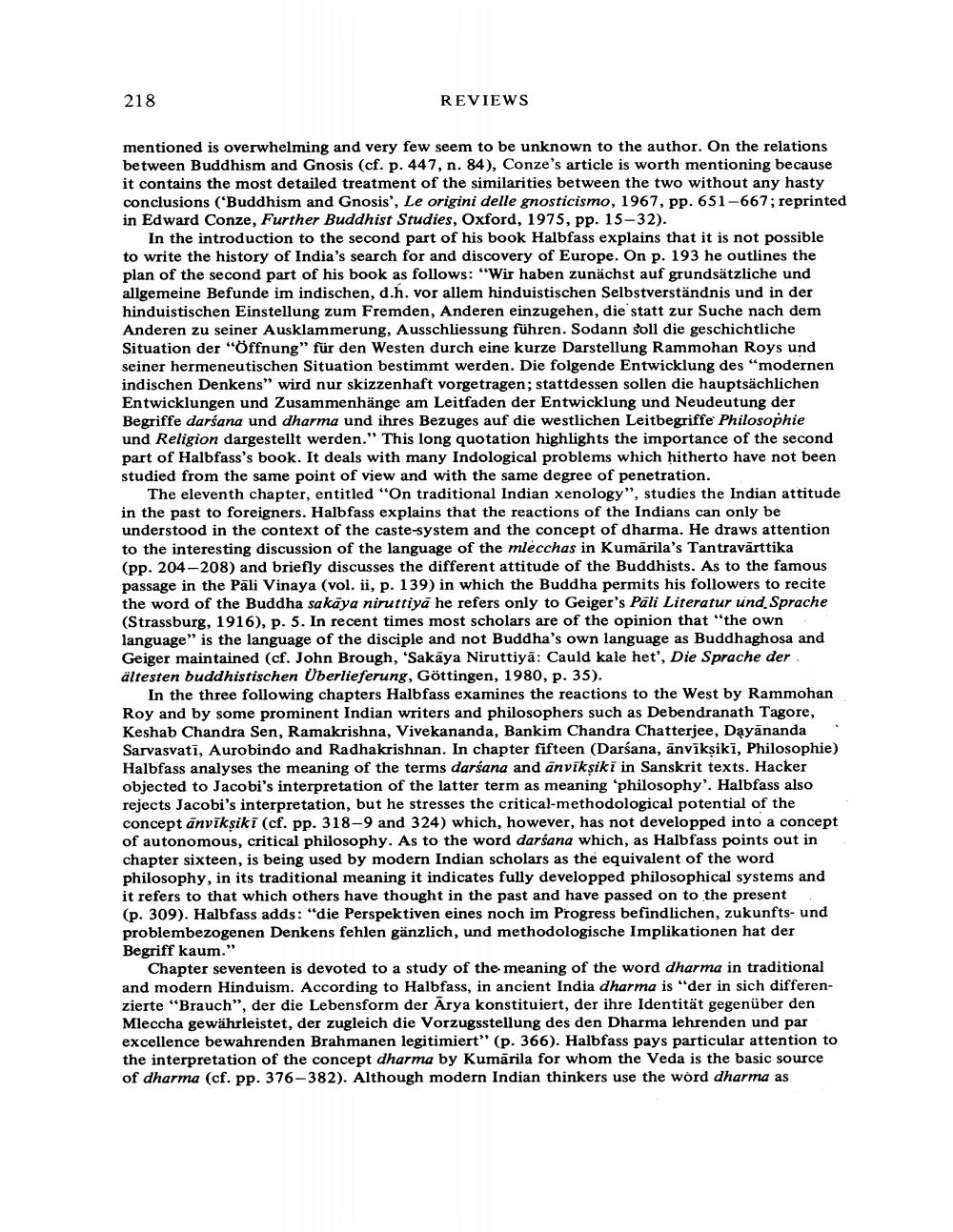________________
218
REVIEWS
mentioned is overwhelming and very few seem to be unknown to the author. On the relations between Buddhism and Gnosis (cf. p. 447, n. 84), Conze's article is worth mentioning because it contains the most detailed treatment of the similarities between the two without any hasty conclusions ('Buddhism and Gnosis', Le origini delle gnosticismo, 1967, pp. 651-667; reprinted in Edward Conze, Further Buddhist Studies, Oxford, 1975, pp. 15-32).
In the introduction to the second part of his book Halbfass explains that it is not possible to write the history of India's search for and discovery of Europe. On p. 193 he outlines the plan of the second part of his book as follows: "Wir haben zunächst auf grundsätzliche und allgemeine Befunde im indischen, d.h. vor allem hinduistischen Selbstverständnis und in der hinduistischen Einstellung zum Fremden, Anderen einzugehen, die statt zur Suche nach dem Anderen zu seiner Ausklammerung, Ausschliessung führen. Sodann soll die geschichtliche Situation der "Öffnung" für den Westen durch eine kurze Darstellung Rammohan Roys und seiner hermeneutischen Situation bestimmt werden. Die folgende Entwicklung des "modernen indischen Denkens" wird nur skizzenhaft vorgetragen; stattdessen sollen die hauptsächlichen Entwicklungen und Zusammenhänge am Leitfaden der Entwicklung und Neudeutung der Begriffe darśana und dharma und ihres Bezuges auf die westlichen Leitbegriffe Philosophie und Religion dargestellt werden." This long quotation highlights the importance of the second part of Halbfass's book. It deals with many Indological problems which hitherto have not been studied from the same point of view and with the same degree of penetration.
The eleventh chapter, entitled "On traditional Indian xenology", studies the Indian attitude in the past to foreigners. Halbfass explains that the reactions of the Indians can only be understood in the context of the caste-system and the concept of dharma. He draws attention to the interesting discussion of the language of the mlecchas in Kumārila's Tantravärttika (pp. 204-208) and briefly discusses the different attitude of the Buddhists. As to the famous passage in the Pali Vinaya (vol. ii, p. 139) in which the Buddha permits his followers to recite the word of the Buddha sakaya niruttiya he refers only to Geiger's Pali Literatur und Sprache (Strassburg, 1916), p. 5. In recent times most scholars are of the opinion that "the own language" is the language of the disciple and not Buddha's own language as Buddhaghosa and Geiger maintained (cf. John Brough, 'Sakaya Niruttiya: Cauld kale het', Die Sprache der ältesten buddhistischen Überlieferung, Göttingen, 1980, p. 35).
In the three following chapters Halbfass examines the reactions to the West by Rammohan Roy and by some prominent Indian writers and philosophers such as Debendranath Tagore, Keshab Chandra Sen, Ramakrishna, Vivekananda, Bankim Chandra Chatterjee, Dayananda Sarvasvati, Aurobindo and Radhakrishnan. In chapter fifteen (Darśana, ānvīkṣiki, Philosophie) Halbfass analyses the meaning of the terms darśana and anvīkṣiki in Sanskrit texts. Hacker objected to Jacobi's interpretation of the latter term as meaning 'philosophy'. Halbfass also rejects Jacobi's interpretation, but he stresses the critical-methodological potential of the concept ānvīkṣiki (cf. pp. 318-9 and 324) which, however, has not developped into a concept of autonomous, critical philosophy. As to the word darśana which, as Halbfass points out in chapter sixteen, is being used by modern Indian scholars as the equivalent of the word philosophy, in its traditional meaning it indicates fully developped philosophical systems and it refers to that which others have thought in the past and have passed on to the present (p. 309). Halbfass adds: “die Perspektiven eines noch im Progress befindlichen, zukunfts- und problembezogenen Denkens fehlen gänzlich, und methodologische Implikationen hat der Begriff kaum."
Chapter seventeen is devoted to a study of the meaning of the word dharma in traditional and modern Hinduism. According to Halbfass, in ancient India dharma is "der in sich differenzierte "Brauch", der die Lebensform der Arya konstituiert, der ihre Identität gegenüber den Mleccha gewährleistet, der zugleich die Vorzugsstellung des den Dharma lehrenden und par excellence bewahrenden Brahmanen legitimiert" (p. 366). Halbfass pays particular attention to the interpretation of the concept dharma by Kumarila for whom the Veda is the basic source of dharma (cf. pp. 376-382). Although modern Indian thinkers use the word dharma as




